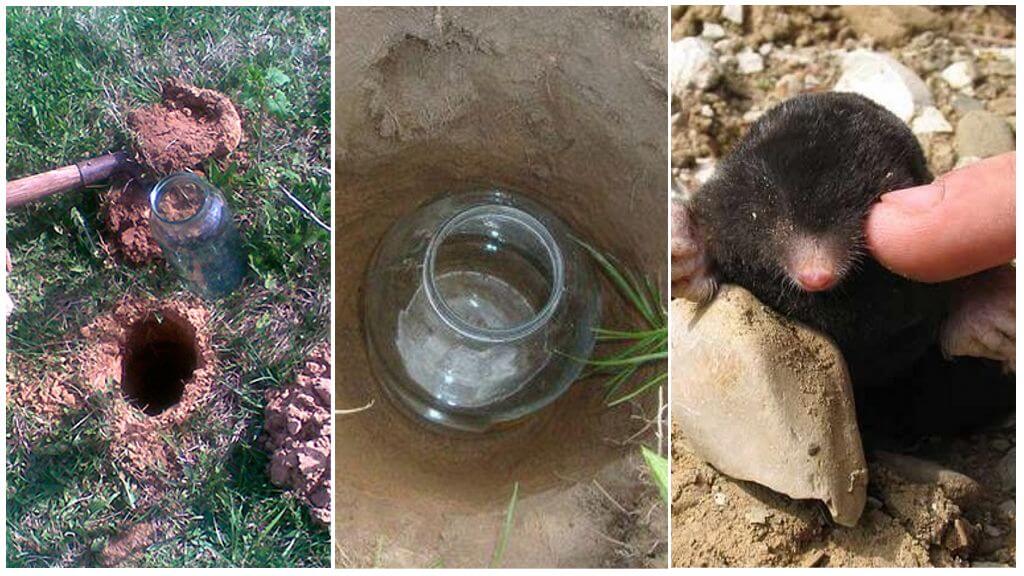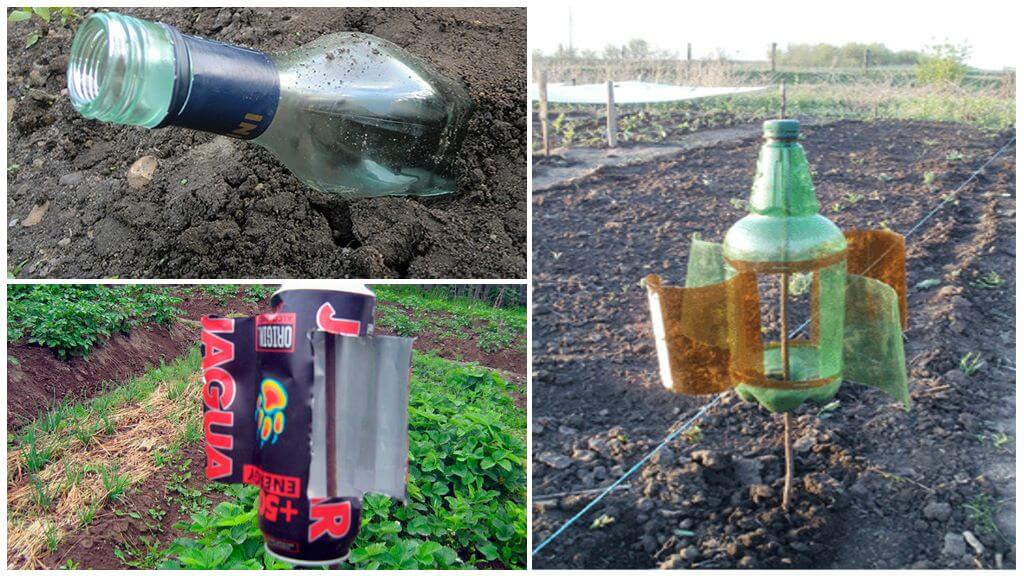- Traditional methods of fighting moles with worms
- Folk recipes to fight the mole
- Mole traps
- Mole traps
- Repeller with an alarm against moles
Mole - an animal about which it can be safely stated that the medicine is worse than the disease. This insectivorous fauna feeds on pest larvae and can completely dig a garden in search of food. When making moves, it damages the root system of garden plants. According to gardeners, pests are better than moles. There is less damage from the first. Since the mole is an “ambiguous” animal, many feel sorry for killing animals. There are many different remedies for moles.capable of harming these digging animals. But, choosing how to deal with moles, gardeners prefer folk remedies.
Types of folk ways
It is impossible to get rid of moles on the site forever with folk remedies, since this underground animalswhich tend to develop new territories. As a consolation: industrial methods also cannot get rid of animals. If you stop taking precautions, the mole population on the site will quickly recover.
Folk methods of struggle take into account the physiology of the mole:
- subtle sense of smell;
- thin hearing;
- moving through dug tunnels;
- the desire to clean your home from garbage.
Ineffective but Applied Methods
The mole feeds on live earthworms and maggots living in the ground. To feed him special poison from moles necessary:
- dig a large enough worm;
- cut it along;
- lay poison in the worm;
- dig a mole;
- put a “charged” worm at the bottom of the tunnel;
- to fill up the excavation and hope that the insectivorous predator will stumble upon the worm before it finally dies.

In this case, only one animal will be destroyed, and they live with whole families. That is, such bait, even within the same wormhole, you need to lay a lot.
Digging up animals one at a time is also a very ineffective and labor-intensive way of fighting moles. In this case, you need:
- finding a mole mound, crush it to fall asleep;
- wait until the mole begins to restore the destroyed communications;
- very quickly, so that the beast does not have time to escape, dig an animal with a shovel;
- kill / carry very far.
Nobody can call such a method of fighting moles effective. The loss of one individual is unlikely to fatally affect the entire mole family, and a lot of time will be lost.
Sometimes the fight against moles in the garden is conducted with the help of water. The burrow is flooded. May help if construction wormhole located at the very beginning or clay soil. In other cases, this method is good for deep watering of trees. He will not make much impression on animals.
On a note!
During the fight against moles, it is not worth destroying earthworms. Among folk methods of struggle, there is one such. But worms do much more good by making moves in the soil. Due to the moves, the roots of the plants receive oxygen. In addition, underground predators feed not only on worms.The absence of earthworms cannot guarantee that moles do not enter the garden.
Average performance

Fighting moles in the country during weekends with the help of digging or poisoning is a futile business. Fans of beautiful flowers can use the mole’s dislike of the smell of some plants and plant in the garden around the perimeter of Grouse imperial. The bulb of this plant gives off an unpleasant odor for underground hunters that can drive moles out of the garden. Scare away moles with the help of folk remedies, it is possible not only to Hazel Imperial. Other options are also used:
- Validol. It is claimed that the smell of the pill is enough to scare away.
- Kerosene. A dampened rag is placed in mole passages.
- Fuel oil. They are also used as kerosene.
- Naphthalene. Tablets are laid out in holes.
- Acetic essence. It can scare off, but evaporates quickly.
- A solution of bleach. A container of liquid is placed in molehills. Chlorine evaporates quickly.
- Tobacco. Any product with a tobacco smell is effective until the tobacco gets wet.
- Castor is not enough. Small containers with oil are placed evenly throughout the area.
- Red ground pepper. Effective before getting wet.
- Herring heads, whey, rotting vegetables, rotten eggs and other organics prone to rotting effectively helps get rid of moles in the garden and at the same time from neighbors in the plot. Sometimes from the owner of the site.
- Tear gas. When using this tool, it is better not to fight moles on your own, but to entrust this matter to professionals.
- Wormwood or peppermint. Suitable only fresh. You have to change every day.
- Legumes They allow you to effectively deal with moles in the garden with folk remedies, fitting well into the overall composition. It is enough to plant plants around the beds and around the perimeter of the garden.
The effectiveness of these folk remedies depends more on the enthusiasm of the owner of the site, which will constantly update them.
Feedback
We were literally tortured by moles in the country. In Belarus there are a lot of them, the soil is convenient for them. We tried all possible plants that should scare away these monsters. I can say that folk remedies of this kind help little. Beasts bypass live plants, and odorous "gifts" laid in burrows caused discontent among neighbors. Oddly enough, ordinary tins hung on ropes all over the site helped. They rang even in almost calm weather. Such moles did not bear.
Svetlana Kazlova, Gomel

To protect against moles, you can use traps. This is not fully a folk remedy and, if desired, a trap can be bought in a store. But it’s easy to do it yourself. To make a molehill, you will need:
- Pieces of plastic pipe with a diameter equal to the size of the mole. The number of segments is optional and depends on the size of the mole family.
- Sheet of thick tin. It is necessary for the device "curtains" at the entrance to the trap.
- Not very soft wire, able to bend at right angles.
- Shears for cutting tin.
After preparing the necessary materials, you can begin to manufacture the molehills:
- Tin is cut into pieces a little less than the diameter of the pipe, and a height greater. Future lower corners should be rounded.
- Pieces of wire are cut, calculating the dimensions so that they extend beyond the walls of the pipe in the upper part.
- Tin pieces are bent around the wire so that the sheet rotates freely around the wire.
- In the upper part of the pipe drill holes for the wire.
- Tin is installed in the tubes so that the lower edge is directed inside the trap.
- The wire is passed through the drilled holes and the upper edge of the tin curtain and bend the ends.
- From the other end of the trap, they make the same curtain.
The mole catcher is ready. The tin curtain will freely let the animal in, but will not allow it to get out.Devices are placed on a personal plot in molehills. In fact, they replace the real tunnel. Then you can periodically check the presence of animals in the mole cattle or “bury” moles there alive. There is a chance that next year the smell of rotten meat will scare away the next family.
Feedback.
From my point of view, molehills are not the most effective fight against moles. Industrial animals kill animals like rats, and shaking out these flattened corpses is not particularly pleasing. Home-made mole traps are also not very convenient to use. If you put them “tightly”, then liveliness is a pity. And digging traps periodically and shaking moles out of them is very dreary.
Alexey, Bryansk
Highly effective folk remedies

Such means include devices that make sounds that are unpleasant for animals. In stores there industrial mole repellersbut fixtures are easy do it yourself.
To scare away you can use:
- cans;
- large volume plastic bottles;
- empty glass bottles;
- alarm clocks on electric batteries.
Cans and plastic bottles are put on sticks stuck in the ground. You can make cuts in the bottle to get a pinwheel effect. Under the influence of the wind, the empty packaging spins and rattles. In addition to sound, vibration is transmitted through the stick to the ground.
On a note!
But fighting moles in this way has some drawbacks: repellers can blow away with a strong wind, and they do not work in calm weather.
Empty glass bottles are buried in the ground at an angle to the horizon. In windy weather, they howl, frightening moles and people. Using bottles is more time consuming than cans on sticks: you must dig in containers taking into account the wind rose. In calm weather, this popular way of struggle does not work either.

With the advent of cheap alarm clocks on electric batteries, this Chinese watch has become the most effective remedy for moles. They work in any weather and within six months do not require any worries. The only drawback is that in six months it is easy to forget the place where the alarm clocks are buried.
To make such a means of struggle is very easy:
- buy 4 small alarms;
- set them at different times;
- put alarms in a half-liter jar with a wide neck and a screw cap;
- put a condom on the jar, pulling it to about the middle of the container;
- bury alarms in different corners of the garden, not forgetting to mark the burial places.
A condom is needed so that moisture is guaranteed not to get into the jar during heavy rains. Alarms ring twice a day at different times. Call duration 1 hour. Of all the popular means of struggle, this one is least dependent on weather conditions, does not emit a smell and does not harm the environment.
Feedback
When moles suddenly appeared in the garden, we thought for a long time how to deal with moles in the summer cottage, if we needed a cottage as a resting place and we did not like the unpleasant smell and rattling of tins. At one forum they advised to bury alarms. Moles capitulated without a fight.
Michael, Tver
The last way to fight moles in a summer cottage with folk remedies is reliable, but very laborious and expensive. Throughout the entire perimeter of the site they dig fine wire mesh to a depth of about a meter. The advantage of this method is that the mesh lasts for several years. Instead of a grid, gardeners often use slate. In this case, the fence will be “eternal”. But slate disrupts the natural exchange of bacteria between the enclosed space and the "free."
Important! The nesting of moles is at a depth of 2 m, and the feeding passages are located under the turf layer in loose soil and at a distance of 50 cm below the surface in hard or often dry land. In the fight against moles with a grid or slate, this circumstance must be taken into account.








